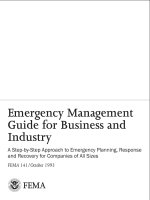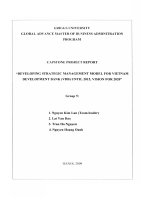Strategic management planning for domestic and global competition 14th ed pearce robinson chapter 6
Bạn đang xem bản rút gọn của tài liệu. Xem và tải ngay bản đầy đủ của tài liệu tại đây (461.62 KB, 39 trang )
Chapter 6
Internal
Analysis
© 2015 by McGraw-Hill Education. This is proprietary material solely for authorized instructor use. Not authorized for sale or distribution
in any manner. This document may not be copied, scanned, duplicated, forwarded, distributed, or posted on a website, in whole or part.
Learning Objectives
1. Understand how to conduct a SWOT analysis
2. Understand value chain analysis and how to use it to disaggregate a
firm’s activities
3. Understand the resource-based view of a firm
4. Use “Three Circle Analysis” as a technique to examine a company’s
product/service attributes with those of key competitors relative to
tangible customer needs
5. Apply four different perspectives for making meaningful comparisons to
assess a firm’s internal strengths and weaknesses
6. Refamiliarize yourself with ratio analysis and basic techniques of
financial analysis to assist in doing internal analysis
SWOT Analysis
A traditional approach to internal analysis:
SWOT is an acronym for the internal Strengths and
Weaknesses of a firm and the environmental
Opportunities and Threats facing that firm.
•
SWOT analysis is a historically popular
technique through which managers create a
quick overview of a company’s strategic
situation.
SWOT Components
• An opportunity is a major favorable situation
in a firm’s environment
• A threat is a major unfavorable situation in a
firm’s environment
SWOT Components (contd.)
• A strength is a resource or capability
controlled by or available to a firm that gives
it an advantage relative to its competitors in
meeting the needs of the customers it serves
• A weakness is a limitation or deficiency in one
or more of a firm’s resources or capabilities
relative to its competitors that create a
disadvantage in effectively meeting customer
needs
Ex. 6.2
SWOT Analysis Diagram
Limitations of SWOT Analysis
•
•
•
•
A SWOT analysis can overemphasize internal
strengths and downplay external threats
A SWOT analysis can be static and can risk ignoring
changing circumstances
A SWOT analysis can overemphasize a single
strength or element of strategy
A strength is not necessarily a source of
competitive advantage
Value Chain
• A perspective in which business is seen as a
chain of activities that transforms inputs into
outputs that customers value.
Value Chain Analysis (VCA)
•
Value chain analysis (VCA) attempts to
understand how a business creates
customer value by examining the
contributions of different activities within
the business to that value
•
VCA takes a process point of view
Value Chain Analysis (contd.)
• VCA divides (disaggregates) the business into
a set of activities that occur within the
business.
• Activities are divided into two kinds
– Primary activities
– Support activities
Value Chain Analysis (contd.)
• Primary Activities
• The activities in a firm of those involved in the
physical creation of the product, marketing and
transfer to the buyer, and after-sales support
Value Chain Analysis (contd.)
• Support Activities
• The activities in a firm that assist the firm as a
whole by providing infrastructure or inputs that
allow the primary activities to take place on an
ongoing basis
Ex. 6.3
The Value Chain
Ex. 6.3 (adapted)
Primary Activities in a Value Chain
Ex. 6.3 (adapted)
Support Activities in a Value Chain
Conducting a VCA
1. Identify activities
2. Allocate costs
•. VCA proponents hold that the
activity-based VCA approach
would provide a more meaningful
analysis of the procurement
function’s costs and consequent
value added than the traditional
cost accounting approach
Ex. 6.5 Traditional
Cost Accounting VS Activity
Based Cost Accounting
Difficulty in Activity-Based Cost Accounting
•
It is important to note that existing financial
management and accounting systems in many firms
are not set up to easily provide activity-based cost
breakdowns
•
The information requirements to support activitybased cost accounting can create redundant work
•
The time and energy to change to an activity-based
approach can be formidable
Resource-Based View (RBV)
RBV is a method of analyzing and
identifying a firm’s strategic advantages
based on examining its distinct
combination of assets, skills,
capabilities, and intangibles
Resource-Based View (RBV) (contd.)
The RBV’s underlying premise is that firms differ in
fundamental ways because each firm possesses a
unique “bundle” of resources
Each firm develops competencies from these
resources, and these become the source of the firm’s
competitive advantages
Resource-Based View (RBV) (contd.)
• Core Competence is a capability or skill that a
firm emphasizes and excels in doing while in
pursuit of its overall mission.
Three Basic Resources
1. Tangible assets are the easiest “resources” to
identify and are often found on a firm’s balance
sheet
2. Intangible assets are “resources” such as brand
names, company reputation, organizational morale,
technical knowledge, patents and trademarks, and
accumulated experience
3. Organizational capabilities are not specific “inputs.”
They are the skills that a company uses to transform
inputs into outputs
What makes a resource valuable?
4 Guidelines:
1. Is the resource or skill critical to fulfilling a
customer’s need better than that of the firm’s
competitors?
2. Is the resource scarce? Is it in short supply or not
easily substituted for or imitated?
3. Appropriability: Who actually gets the profit created
by a resource?
4. Durability: How rapidly will the resource depreciate?
Elements of Scarcity
•
•
•
•
Short Supply
Availability of Substitutes
Imitation
Isolating Mechanisms:
• Physically Unique Resources
• “Path-Dependent” Resources
• Casual Ambiguity
• Economic Deterrence
Using RBV in Internal Analysis
It is helpful to:
• Disaggregate resources
• Utilize a functional perspective
• Look at organizational processes
• Use the value chain approach









